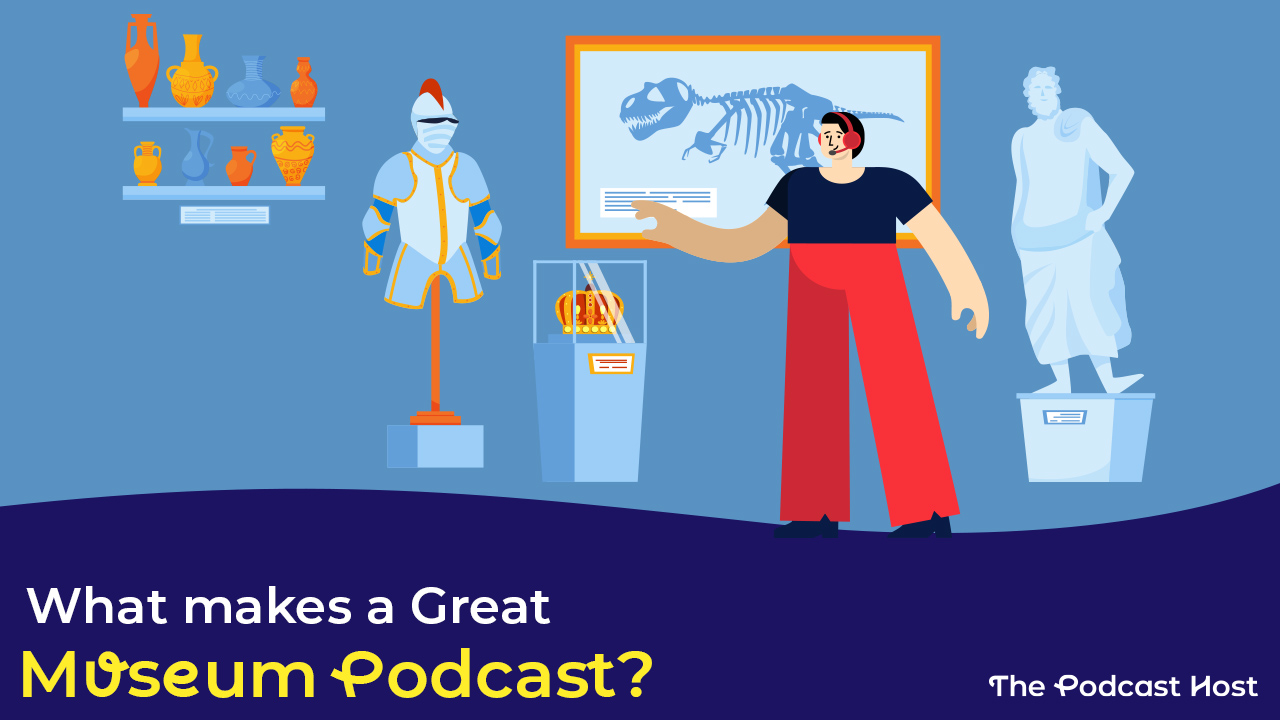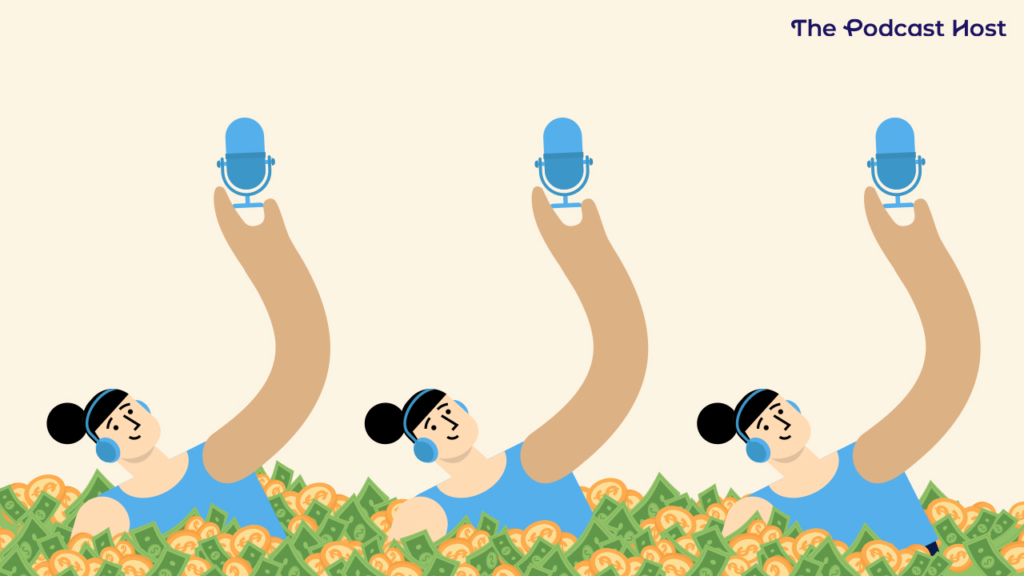What Makes The Best Museum Podcasts?

Since the Covid-19 outbreak, UNESCO estimates that 90% of the world’s museums are now “facing full, partial or eventual closure.” To encourage more engagement, many museums have been making digital content available online.
Podcasts are the simplest and most effective digital content mediums museums can use to engage visitors, members and donors. They can also aid accessibility and do great things for a museum’s PR too. But education, entertainment and promotion are all complex endeavours on their own.
Let’s look at how podcasts can help museum organizations make audio art, contextualise collections, and dive into some of the best museum podcasts available right now.
The Best Museum Podcasts: Obstacles and Superpowers
Museums aren’t just walk-through display cabinets. They show social and cultural change over time. Museums are gathering spaces for people to learn from each other, but not everyone understands this. In February 2020, arts leaders spoke in a panel discussion about the challenges facing museums.
“Our contemporary moment is a culture of meanness,” said Anne Pasternak of the Brooklyn Museum of Art. “It’s not based on facts. It’s not based on conversation… it’s destructive to our democracy and our institutions.” Discussions about donor ethics, cultural appropriation, inclusion and exclusion lack nuance. Some people feel that museums only please wealthy donors and powerful corporations. Others feel that museums’ collections are too “woke” for their kids. With social media, these broad, multifaceted issues have been reduced to tweets or hashtags.
During the pandemic lockdowns, virtual programming kept museums afloat for a little while. Connecting people with cultural touchstones is a big burden. Today, most museums have revived indoor gatherings. But digital content still goes a long way toward aiding accessibility and understanding.
Good museum podcasts excite emotions, inviting guests and providing context to their collections and activities. The best museum podcasts, though, aren’t simply descriptions of the artefacts. They’re audio art that complements the organization and collection. Museums hold objects that are uniquely inspiring. Using that inspiration to make a podcast takes the whole experience above and beyond our daily lives. The best museum podcasts can incite a sense of wonder to make guests and patrons invest emotionally in the organization.

One Museum, Many Functions
Museums inspire and educate. They’re also a place where people go to kill a few hours, socialize, meet new people, or simply avoid bad weather. Some people think they’re a place to entertain their kids. Others see them as a place to make their legacy. Podcasting can support and enhance all of these functions.
Gallery Podcasts: Enhanced Audio Tours
The most obvious way that a podcast can increase understanding is through self-guided audio tours. Imagine walking through The Philadelphia Museum of Art’s South Asian Collection. You find The Face of Bhairava. This intricate wood and copper mask dating from the 16th century has brown, bulging eyes, long ears, and a toothy grin. It’s not an inviting face. If it were crowded, you might be unable to see its details or read the card’s information. Plus, you might be tired and in need of a snack. Without knowing why this object was made, how it was used, or what makes it special, it’s hard for museum guests to care about it or remember it.
Or, you could listen to this:
Pairing the description with traditional music and relevant ambience, gallery visitors can recognize what this mask made people feel five hundred years ago, in a festival still celebrated in Kathmandu today. Together it shows the universality and timelessness of humans’ wilder nature. To put it bluntly, it’s reminiscent of any fun time you ever caught something delicious in your mouth. Like this hypothetical audio snippet example, podcast episodes can make every artefact in the museum mean more to guests.
Self-guided audio tours with listening devices have been a staple of the museum experience for decades. Unfortunately, they’re extra work because of equipment maintenance and retention, not to mention the cost. With museum podcasts, guests can use their devices and earbuds or headphones to listen to the content.
Listening to a podcast through headphones can also relieve some users’ pressure from crowds and distractions. People with ADHD or autism can let the podcast provide an extra layer of helpful stimuli. Of course, it can also help anyone tune out other museum guests if they want solitude.
Virtual Programming
Virtual events such as lectures, panel discussions, and workshop activities foster community and aid understanding. They increase accessibility as well since guests can enjoy them at home. The Metropolitan Museum of Art relies on Zoom meetings for virtual events. These Zoom sessions allow people to ask questions and engage with the presenter – if that’s part of the program. A podcast can do this too, but the best museum podcasts can improve on audio quality and understanding.
Podcasts already use lectures and panel discussions. Usually, they happen in large galleries with high ceilings. The reverberation can make it harder for the audience to understand the speaker. However, podcast producers can focus the presenters on their microphones and record in a smaller, sound-treated space.
Service interruptions from unpredictable internet bandwidth can be a problem with videoconference software. If the user doesn’t have a great internet connection, they can miss out. Zoom has security settings in place to prevent “zoombombing,” or inappropriate behaviour. But they depend on how savvy the host is about the settings. Podcasts avoid this problem completely because they’re pre-recorded. Since the audience downloads the episode to their own devices, they don’t have to worry about garbled dialogue or losing the connection completely. The best museum podcasts let the audience consume the experience at their own pace with reliable continuity.
Cultivating Donor Relationships
Anyone who has heard a brand podcast knows that the intimacy and trust podcasts build can convert sales. People don’t just listen to the Inside Trader Joe’s podcast for the banter. They listen to learn more about the food before buying it and feel good about shopping there.
Face-to-face interaction and handwritten thank-you notes are irreplaceable parts of a nonprofit’s strategy. But podcasts can also say thank you. The best museum podcasts show the impact of donations as effectively as they provide context to exhibits. An impact report can include a paragraph about how your museum works with schools and colleges. Or, a museum podcast can include direct quotes from students themselves. Donors can hear exactly how the artefacts and workshops benefit them.
Podcasts can command prospective donors’ attention too. They can reward current donors by showing the impact their donation makes. Plus, they can build a foundation for future support by being something donors want to participate in.

How To Create a Great Museum Podcast
To run a great museum podcast, you need a great plan first. Asking the big questions early will help you budget resources for your museum podcast and sustain it for the long run.
Choose a Type of Museum Podcast
Do you want to have one podcast to promote your museum, or do you want to have multiple podcasts? Public, private, or both? Each RSS feed can serve a different function and demographic. For example:
- A public podcast promoting new exhibits, permanent collections and special events.
- A private podcast only for donors, as a benefit.
- A kids’ and families’ podcast that promotes the museum, gives context to the exhibits and prepares them for their visit.
- A private podcast accessible only to ticket-holders to stream or download as they move through the galleries.
- A combination of any or all of these.
No matter which type of museum podcast you go for, the hosting service you choose is paramount here.
What you choose affects the budget, and your choice of media host. Some charge by download numbers, others by data uploaded, number of RSS feeds, amount of analytics, and more. From my experience, it’s best to start producing one podcast rather than planning to make many specific ones. Producing a podcast is like eating potato chips: once you’ve had one, you want many. The goal is to complement your institution, which means sustaining it for a long time. Start small and let it grow.
Decide Who Will Produce Your Museum Podcast
Like The Guennol Lioness, you get what you pay for. Don’t delegate this to a volunteer. The best museum podcasts are integral to their institutions’ public relations and marketing strategies; cutting corners can cut quality.
That being said, if cost is a factor, you can make an excellent museum podcast without too much fiscal agita. You can hire a podcast producer or subcontract to a podcast production company. Or, you can create a role in your marketing and PR department for someone to produce your museum’s podcast. If they have experience producing podcasts independently, they should be able to propose a reasonable budget and workflow. It’s not expensive to make a museum podcast with NPR or BBC-style immersive sound.
Whichever you choose, work with someone invested in the life and ongoing health of your organization.
Ensure Your Museum Podcast Will Be Accessible
In terms of logistics, how’s the internet access in your building? Can you listen to a podcast anywhere and everywhere inside it? You may want to invest in a wifi system that doesn’t depend on line of sight, like a wireless mesh network. If one of your major donors is a telecommunications company, they might be willing to help in exchange for promotional consideration.
Regarding listener accessibility, make sure you clearly title your episodes, particularly for gallery tours. To remove any doubt, include the item’s accession number at the end of the episode title. A museum podcast for Matisse’s paintings during the interwar period could have difficulty telling one Odalisque from another. Each gallery card can have a QR code linked to an embedded player in your museum’s website. This skips lots of steps in the user navigation process.
Transcripts always improve accessibility and are essential to make sure your podcast’s content is crystal clear.
5 of The Best Museum Podcasts
There are quite a few podcasts about museum culture in general, such as Museum Confidential or KCRW’s Art Talk. It’s challenging to find podcasts meant to connect specific museums with people. But some museum podcasts have engaging, evergreen content. Here are some standout examples.
1. The Object
Minneapolis Institute of Art’s The Object balances the description of artefacts with history and social context to create an experience on par with This American Life. The music, speaking cadence, and depth of information all work together to make a resonant experience. Try out Episode 44, The Ghost Ships of Xu Fu, which connects a Qin-dynasty search for the fountain of youth to Minneapolis’ Asian-American community today through Cy Thao’s 50-painting series, The Hmong Migration.
2. Immaterial
If the Mona Lisa were painted with watercolours or scratched into clay, it would have a completely different effect on us. The Metropolitan Museum of Art’s Immaterial examines materials artists used at different times in history to make art and what this shows us about that time and place. Each episode examines a particular material, such as paper, jade, or shells, and shows us what we can learn about the world.
3. Sidedoor
The Smithsonian Institution includes 21 museums and the National Zoo. It houses over 157 million objects and specimens. That much history and culture can be confusing. Fortunately, Lizzie Peabody and PRX are here to help us through Sidedoor. She presents the stories behind the Smithsonian’s overlooked or misunderstood artefacts, such as Edison’s talking doll disaster, wild American ginseng, Chef Lena Richard, and hundreds more, to show a better understanding of America.
4. The Buffalo History Museum Podcast
Who knew Western New York was such an exciting hotbed of history? The Buffalo History Museum Podcast‘s music, sound effects and narration make a contagious experience that makes you want to visit Buffalo. Come for stories about Harry Houdini and Nikola Tesla, and stay for the liminal danger at the intersection of wilderness and settled society.
5. My Favorite Malady
Though the Mütter Museum’s podcast only has a few episodes and its minimalist sound design wavers, My Favorite Malady should be on every list of the best museum podcasts for its candid commitment to public health. This direct and outspoken examination of illness throughout history will compel you to wash your hands, brush your teeth, pay your taxes and treat others with compassion. Not only do they explain disease accessibly, but they respectfully remember the people who survived illness or gave their lives for medical science.
Museums and Podcasts Can Elevate Discourse Together
Holland Cotter, co-chief art critic of The New York Times, wrote in 2016 that:
“[A]s generators of life lessons, shapers of moral thinking, explainers of history, [museums] no longer matter because they’re not asking people to look for any of that. Could anything change this dynamic? Maybe telling the truth about history, including their own, could.”
Podcasts are built for storytelling and connecting people with complex ideas. Well-crafted podcasts like these could help museums build bridges between their communities and collections and illuminate complex histories.
